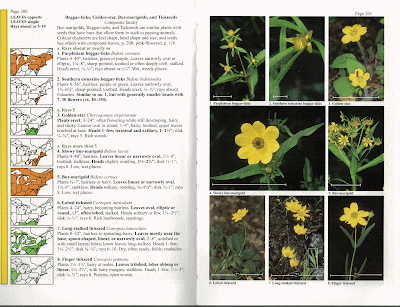It's no secret that I have a "problem" with field guides. My problem is that I feel the need to have them all. This means that they occupy a lot of shelf space (and table space and sometimes floor space) at my home. It also means that I have a bit of experience using different field guides. When I do programs for adults, I frequently get asked about the field guides that I would recommend for use or purchase.
With Christmas coming soon, now is the perfect time to think about purchasing field guides as gifts or about which guides you want to add to your list. Here are a few of my recommendations.
Field Guides to Plants
1. Wildflowers in the Field and Forest: A Field Guide to the Northeastern United States by Steven Clements and Carol Gracie (ISBN: 9780195150056).
Published by the Oxford University Press in 2006, this book is not cheap (new copies currently cost $55), but I believe it is totally worth the price. This is my go-to book for wildflowers. It is simply the most comprehensive book of wildflowers to the Northeast and Great Lakes. While I have found flowers that were not listed in this book, I can count them on one hand. I like this book so much that I own two copies - one is my everyday user and the second copy is for when I wear out the first copy.
In addition to the fact that this book is so comprehensive, I like how his book is laid out. Flowers are divided first by color, then by leaf arrangement, and finally by flower arrangement/number of petals. There are good descriptions of each species as well as clear photographs of the flowers and often close-up images of details that help with identification. There are also range maps for the region. I wish every wildflower book was laid out this sensibly. The book is quite large 5 inches by 8 inches and somewhat heavy, but the weight is worth carrying around in a backpack or shoulder bag if you are going to be identifying wildflowers all day.
2. Michigan Trees: A Field Guide to the Trees of the Great Lakes Region by Burton V. Barnes and Warren Wagner, Jr. (ISBN 9780472089215).
Published by the University of Michigan Press, this is the best available reference guide to the trees of Michigan. It has been published in one form or another since 1913. The current (revised and updated edition) was published in 2004. The softcover edition of this book sells for under $20 - a great value for such a comprehensive well-organized guide.
Each species in this guide has its own two page spread with a detailed description and illustrations. At the back of the book there is a smaller section that details some common shrubs found in the state. Again this is not a pocket-sized book, but if you are spending the day looking at trees this is the book you want to carry along.
3. Wetland Plants of Michigan: A Complete Guide to the Wetland and Aquatic Plants of the Great Lakes State by Steve W. Chadde (ISBN 9781481194945)
This author-published book is on its second edition (2012). The book retails online and in stores for under $30. This book is not as easy to use by a beginner as the previous two books. It is divided by family - if you don't know the family it is best to use a different book. However, it is still a useful guide, especially for those interested in identification of wetland plant species. Each section of the book includes a dichotomous key that is useful for distinguishing between similar species. Each species entry includes a good description of the plant, the plant's wetland classification, and a map showing which Michigan counties the species has been found in. This useful feature was not included in the first edition and is a welcome addition to the book. The book includes both line drawing and photographs (black-and-white only) of the species.
This book is not intended to be the first guide that someone owns.If you already own a few books about wildflower and trees and want to delve deeper, then I would recommend this book. This book has more than 680 pages and is not pocket friendly, but is a valuable addition to the bookshelf.
4. A Field Guide to the Natural Communities of Michigan by Joshua G. Cohen, Michael A. Kost, Bradford S. Slaughter, and Dennis A. Albert (ISBN 9781611861341).
Published by the Michigan State University Press in 2015, this book retails for $34.95. This book is not a guide to individual plants, but rather is a guide to plant communities or habitat types. Developed by scientists at the Michigan Natural Features Inventory, this book highlights more than seventy distinct natural community types found in Michigan. The book gives a description of each community which includes a map showing where the community can be found in the state, a list of characteristic plants, and a list of locations of specific sites. The book also includes a key that can be used to identify the class of an observed habitat.
This a great book to consult before going out into the field or after coming back from a trip. It is less useful as a "field" guide. That being said, this is a valuable addition to the library of anyone wanting to learn how larger plant communities work and interact.
That's it for field guides to plants. Look for Part 2 (Insect field guides!) tomorrow.










No comments:
Post a Comment